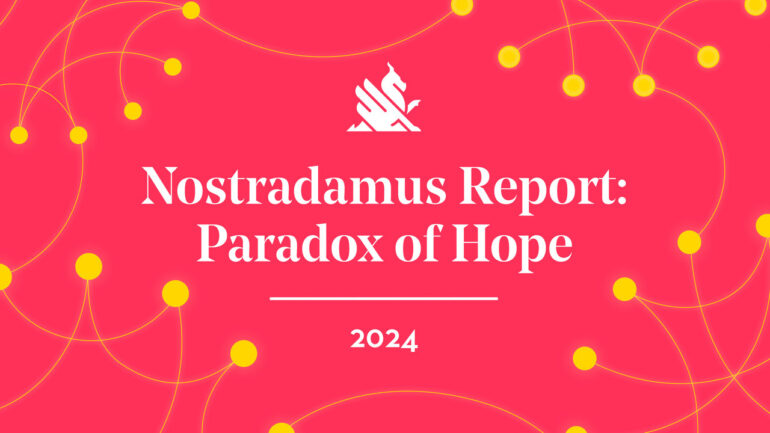WRITTEN BY: Davide Abbatescianni
The film industry is navigating rough waters, but there are still reasons to remain optimistic, says Johanna Koljonen at the presentation of the 11th edition of the report, held in Cannes on 20 May.
On 20 May, Cannes’ Marché du Film hosted the presentation of Göteborg Film Festival’s annual Nostradamus report, authored by media analyst Johanna Koljonen.
The document, titled Paradox of Hope – A Creative, Resilient Industry, comes at a time of unprecedented transformation in the film and audiovisual industry. “Looking three, five years ahead, some things will be inevitable, some others can take really different paths depending on our industrial decisions,” says Koljonen.
The heart of this new report is the expert interviews, which involved speakers from film funds, festivals, exhibition networks, markets and media research, among others.
In the first chapter, “Paradoxically Hope”, the media analyst states how “everything is broken”, as we witness wars, climate crises and growing food insecurity, while the impact of these emergencies is being aggravated by populist leaders in autocracies and democracies alike. One might consider the state of the film industry at a lower stake when compared to the aforementioned matters, but storytelling remains key to our cultural development and our future as a species.
What is certain is that the whole sector is driven by an “untenable business model,” and “everything we work on is fundamentally or temporally broken, or reaching a breaking point,” Koljonen explains. But, paradoxically, people working in the industry feel hopeful, although many know that “numbers don’t make sense” and acknowledge how the sector is increasingly disconnected from the audience and from reality.
The second chapter, “Confronting Theatrical Overabundance”, tackles one of the “elephants in the room”. “It’s a nice, polite way of saying we release too many films in theatres,” Koljonen points out, adding how the basics are easy to understand. “20 years ago, admissions were doing incredibly well, and kave collapsed ever since. Even if we look at the last five years, we realise it’s a mathematical problem.”
The exhibition suffers from many problems, including the rising cost of tickets (going up faster than the inflation), the longer run of films, the higher number of titles “but not necessarily easier of access”, the inability to communicate and create “a sense of occasion”, the struggles to spread the word of mouth, and the reluctance of admitting that some films simply don’t work in theatres. Priorities remain to revitalise cinema-going, growing the audience of auteur cinema, building a sustainable audiovisual industry, and backing a pipeline of auteur filmmakers.
“We tried to solve some of these problems by releasing more films in theatres, and that didn’t work. We should ask ourselves what is the appropriate number of theatrical releases that are sustainable for the sector, and for cultural policy goals. Do we need more cinemas in ‘cinema deserts’? Do we need to run shorter or longer events? We either need fewer films that are economically ‘reliable’ or the ecosystem has to change – or perhaps a bit of both?”
Koljonen ultimately wishes the industry would discover solutions through innovations rather than bankruptcy.
The third and four chapters, “Engagement Theatrical as the New Normal” and “New Opportunities for Strong Voices”, stress the concept of relevance, inviting the industry to abandon “lazy programming”, and build engagement. As audiences are more and more selective about their theatrical ‘picks’, films need to be both “personally engaging” and “proactively engaging”. Thus, the industry needs to move away from the stagnating idea of ‘arthouse audiences’. To Millennials, Gen Z and Gen Alpha viewers, the concept “has never been true”, argues Koljonen.
“To them, film is content in the sea of content. They’re happy to visit an arthouse theatre for a specific film, but that doesn’t automatically make them ‘arthouse aficionados’. We’re losing a ‘guaranteed audience’, which is not necessarily that young, as Millennials are now hitting their 40s.”
The fifth chapter, “Collaboration as Innovation”, emphasises the need of sharing knowledge and testing new practices. As small cinemas don’t have the means to pursue innovation, collaboration among producers, distributors and exhibitors is essential to adapt to change and create immersive environments in theatres.
The sixth chapter, “New Tools, New Potential, New Self-Understanding”, takes stock of the “storm of new tools” entering workflows, including AI and virtual production, acknowledging how their “legal environment is still unclear”.
One of the interviewees, Vice President Drama of ZDF Studios Robert Franke, argues that in three or five years most of the production work will be completely transformed by AI. The short time span of this transition period, says Koljonen, will make it hard to find “matching and complimentary expertise”. Moreover, she underlines that most of this sector’s workers are freelancers, so there will be a massive need for “reskilling and retraining the entire workforce to adjust to new work procedures”, but this may not be an orderly process as would happen within more structured companies and organisations. “If we don’t do work on this aspect, efficiency losses will be huge,” she sums up.
The seventh chapter, “Big Brother Arrives”, explores the wider ecosystem of “connected TV”. Koljonen comments on how content and ads are often targeted incorrectly, and AI is in part helping to solve this problem. Improved content discovery and targeted ads may increase engagement and paradoxically benefit theatres (“showing the right trailer to the right person”), but disengagement risks remain.
The last chapter, “Epilogue: A More Human Industry”, looks at our world “squeezed by artificial tools” facing threats of “synthetic media as well as fully or mostly AI-generated content which will compete for audience attention very soon, and really clumsily at first”. Therefore, keeping a human-centric approach in filmmaking and industry practices remains crucial. That’s where the titular “paradox of hope” comes about: “Everything in the world remains pretty bleak, but as long as we don’t give up hope, there’s hope. Film and film storytelling will continue with or without the structures of this industry.”
To the full report: CLICK HERE.

